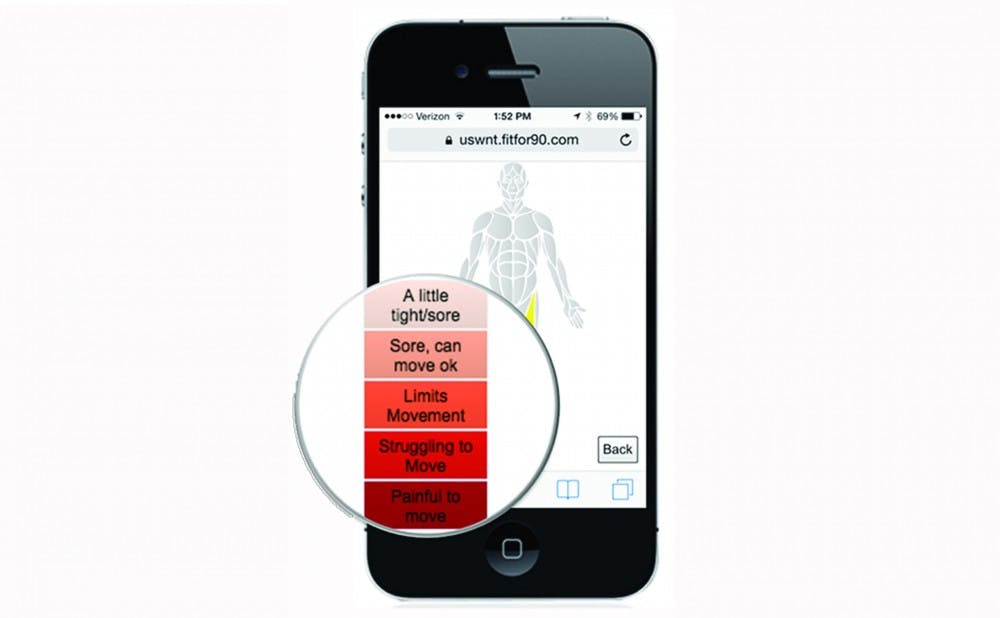Every morning, the Blue Devils open an app on their phones and spend two minutes inputting their energy levels and any areas of soreness so that the Duke coaching staff can devise a customized practice plan to maximize performance.
The technology, Fit For 90, is part of Duke’s new, science-backed approach to training it adopted heading into the season. Adhering to shorter, more intense practices and doing more work off the pitch, the Blue Devils are hoping their new method will pay off by keeping them fresher—and healthier—late into the season.
“We had done things a certain way for a long time. They had been successful, but I think they had run their course,” head coach Robbie Church said. “We knew that we needed to change, but you’re never really sure, especially [with] something new.”
After missing the NCAA tournament for the first time since 2002 last season, Church decided to re-evaluate his program. The addition of two new members to the Blue Devil coaching staff ushered in some fresh ideas, including Fit For 90. Assistant coach Erwin van Bennekom and goalkeepers coach Brandon Gwin each had prior experience with the system, Church said, and they teamed with long-time assistant coach Carla Overbeck in convincing him to give it a chance.
Created by former Portland Timbers director of sports science John Cone, Fit For 90 gives coaches new insight into their team’s readiness for action. The software asks players to rate their freshness, mood, stress level, hydration level and sleep, as well as pinpoint exactly which joints and muscles are sore. By sharing the team’s schedule with Cone, Church receives a shell around which to build his practices, adding in the needed tactical work within the specific time constraints designated by the software.
“One of the big things that’s never been effectively quantified is how much energy a player has, so the coaches go into training sessions and they’re really blind,” said Cone, a former assistant coach at North Carolina who also holds a Ph.D. in kinesiology. “They don’t know how much have the players have, and how much energy they have really dictates what you can do as a coach.”
The Blue Devils are far from the only team to benefit from the Fit For 90 platform. The U.S. Women’s National Team began using it in August 2014 when it began training for this summer’s World Cup, and the app fully launched last December. Since then, Fit For 90 has been adopted by several Major League Soccer teams and college teams including Wake Forest and California. The product is also the official monitoring system of two youth leagues and has extended into other sports beyond soccer.
Fit For 90 has helped Church create tailored practice plans. Now, he is able to rely on his players’ ratings to gauge their health instead of putting them through a rigorous routine in practice that could grind on the Blue Devils’ legs as the season progresses.
“It kind of gives you a skeleton of what to do at practice, and you put in what you need to do within these time limits. It’s scientific-based so you’re not guessing,” Church said. “Instead of doing an activity for 20 minutes and probably eight of those being game-like and the other 12, we’re just trying to get through. Now we’re trying to do eight or nine minutes all at game-like speed.”
Using Cone’s planning system has produced practice lengths that run shorter than in prior years, meaning Church has turned to a new method to keep his team in shape—pool workouts.
“I think we’re growing some gills. We’ve been in the pool forever instead of beating the joints out on the field all the time,” Church said. “You look at them and they’re fresher than they have been, there’s less injuries and they’ve enjoyed it. We’ve been on the field a lot less, but they’re fresher.”
Sophomore Imani Dorsey—who missed three games due to a strained hamstring before returning Friday at Samford—said that while she was hurt, she spent practices doing the drills she felt well enough to do and sitting out of others. Based on the players’ responses, the coaching staff can customize the number of times each player competes a drill to preserve energy and prevent injury.
“During that time you go 100 percent and you go all out,” junior captain Christina Gibbons said. “I think that’s really changed for us—instead of having these long practices where you’re struggling to find energy, everything is quick and intense and hopefully that’s a repetitive habit that we bring out in games.”
Get The Chronicle straight to your inbox
Signup for our weekly newsletter. Cancel at any time.

